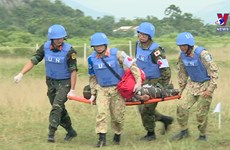Mekong Delta expects 150 “special” medical experts
The CTUMP expects to have 150 graduates who specialise in tuberculosis, forensics, leprosy, anatomical pathology and psychopathology by 2020 to ease extreme shortage of specialised physicians.
 Illustrative Image (Source: VNA)
Illustrative Image (Source: VNA)According to Prof. Pham Van Linh, the university’s rector, this number will satisfy only 15 percent of demand, as the region now needs about 1,000 experts in these subjects.
Very few students pursued a degree in these specialties, as they would have to work long, irregular hours and face various health hazards, including constant exposure to infections and diseases.
In additional, preferential policies are not attractive enough due to a lack of state funding.
Deputy Head of the Southwestern Steering Committee Nguyen Quoc Viet stressed the need to offer more financial incentives to medical specialists, because their salary range is relatively lower than those in other areas of medicine.
He urged for more financial support from the Government to help the CTUMP improve its facilities. He also suggested the university increase the length of apprentice training in these five programmes.
The Can Tho University of Medicine and Pharmacy said the delta had the lowest doctor-to-patient ratio in the country.
More than 70 communes in Kien Giang province have no doctors, while Soc Trang province has 3.89 doctors per 10,000 residents.
In 2014, the rate of medical workers increased to 6.17 doctors and 1.13 pharmacists per 10,000 residents, compared to 4.26 doctors per 10,000 residents and 0.22 pharmacists per 10,000 residents in 2008.
To ensure the target of nine doctors and two pharmacists per 10,000 people, the university should train an additional 5,800 doctors and 2,400 pharmacists by 2020, according to Linh.
However, statistics from the University show that for the 17.6 million people in the region, there are only 9,200 doctors and 1,200 pharmacists.
This represents a rate of only 5.27 doctors and 0.73 pharmacists per 10,000. To comply with the decision, the area would need more than 3,000 doctors and 655 pharmacists.-VNA













